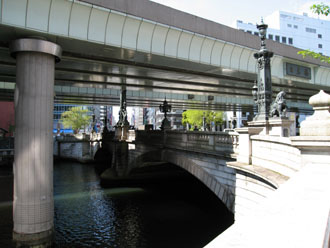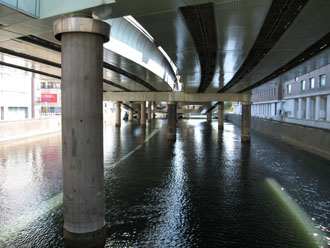Reinstatement of Cityscape and Landscape | Based on the Discussion to
Relocate the Overhead Expressway Spanning the Nihonbashi Bridge
(Reproduced in English from the Japanese issue published May 12, 2006 and revised July 2, 2006 with the permission of Osaka Owners' Association of Registered Tangible Cultural Properties of Japanhttp://www.culture-h.jp/tohroku-osaka/bun7.html )
Issued August 15, 2006
Yoshihisa Hayashi Project Chief of the Cultural Properties Protection Section, Osaka Prefectural Board of Education
Koichi Hatada Prof. Emeritus of Osaka University
(English translation by Koichi Hatada and Susumu Kuwabara)
As many of you may know, "the Nihonbashi Bridge (hereinafter to be referred to as "NIHONBASHI" for short)" which means the Bridge of Japan, spans the Nihonbashi River in central Tokyo. This bridge is well-known for the ukiyoe painted by Ando Hiroshige in the Edo Period (1603 - 1867) and the song familiarized by the verse "Oedo Nihonbashi Nanatsu-dachi ................ [meaning 'Start from Nihonbashi in Edo (old name of Tokyo before the Meiji Restoration) at seven in the morning for a trip outside Tokyo................]." In the Edo Period NIHONBASHI was the starting point of Japan's land planning to measure distance. It was the focal point at that time where the country's five major roads connecting Edo and other big cities in Japan originated.
As a matter of fact, present NIHONBASHI is not the original arched wooden bridge built in the Edo Period, but is an arched stone bridge constructed in 1911 in the Meiji Era (1868 - 1912). It was declared in 1999 an architecture classified as important cultural property in view of its value as a modern industrial heritage.

Although NIHONBASHI has been evaluated and designated a precious cultural heritage, the Metropolitan Expressway, built in 1964 above the Nihonbashi River in the time of the Tokyo Olympics, now crosses over NIHONBASHI with an overpass, blocking the view of the sky above the bridge as a result. When cityscapes are now being reexamined at various places throughout Japan, we can see a movement in the Nihonbashi area to relocate the Metropolitan Expressway spanning NIHONBASHI, involving a plan to revitalize the area. Sponsored by Prime Minister Junichiro Koizumi, an advisory panel of well-informed intellectuals under the name of "Meeting to Bring Back the Sky to the Nihonbashi River" has launched to discuss various possibilities including the relocation of the expressway to submit a proposal in September 2006.
Cityscapes with expressway overpasses spanning rivers or roads may well be said to characterize big cities in present-day Japan. Such a cityscape is also true in Osaka where we live. Osaka is now striving to bring back its traditional characteristics cherished since the Edo Period as Water City Osaka and to revitalize a bustling and livable city by developing riversides under the slogan of "Osaka, Capital of Water." However, in the Higashi Yokobori River and other rivers in Osaka, expressways crisscross above them with thick supports thrust into the water surface of the rivers (waterways) that must play a lead role in the project. Bridges, used to be called symbolically the "Eight Hundred and Eight Bridges of Naniwa (alias of Osaka in the old days) " to express the large number of bridges in Osaka, now look downhearted, surrounded by the gloomy environment clad in exhaust gas and without the view of the sky. Under such circumstances, the revitalization of the Capital of Water may end up in just calling the slogan. Thus the problem of the expressway spanning NIHONBASHI does not seem limited only to Metropolis Tokyo.
The newspaper column "Plaza for Contention, Proposal and Discussion"(Ref.1) introduced the contentions of three people regarding the relocation of the Metropolitan Expressway as summarized below.
Mr. Kikuzo Hayashiya, 69, Japanese comic (rakugo) storyteller, says, "To people born in Tokyo, the expressway hung over NIHONBASHI eDOES NOT LOOK GOODf. IT ISN'T JUST A MATTER OF LOGIC.h Then he goes on to say, "The restoration of the town of Nihonbashi as a whole would enable us to get to know the basics of present-day Japanese culture. Removal of the expressway symbolizes it." " I think that to recover the cityscape of NIHONBASHI means that each and every one of the Japanese people recovers the chromosome of nostalgia buried in the past." says Mr. Hayashiya.
On the other hand, Dr. Taro Igarashi, 39, of Tohoku University, advocates that the expressway covering all over the Nihonbashi area is a "road of miracle", built by the joint efforts of engineering officials of the Tokyo Metropolitan Government and industrial circles throughout Japan, which astonished the road engineers of the world. Based on his evaluation with emphasis on the engineering property of the expressway and the non-economic efficiency of relocating the expressway, Dr. Igarashi wonders "whether or not Europeans will think of beautiful Japan when they look at NIHONBASHI of western style which would pale against bridges seen in Western cities. In this context, Dr. Igarashi insists that the present condition should be preserved, saying that "they would feel the dynamic composition of Japanese cities from the very violent act of constructing a bridge over a bridge."
In contrast to these contentions expressed, Dr. Osamu Shinohara, 61, of Tokyo University puts forth his views, based on the historical analysis of the construction of the Metropolitan Expressway and the changing evaluation with time of the expressway at issue, that the question is not whether the design is good or bad but rather lies in the philosophy regarding cityscape as well as the judgment on the locality in the city. The judgment on the locality means that the Nihonbashi River is the canal dug first at the time of building Edo Castle and the grass roots of Capital Tokyo and also that NIHONBASHI is the bridge which became the starting point of the land planning as the originating point of the five major roads. In view of these facts, Dr. Igarashi strongly stresses to recover the pride cherished since the Edo Period by relocating the expressway.
As stated above, these people have different views and ways of thinking respectively toward the present state of NIHONBASHI. But judging from their ages, it seems that their ways of thinking vary with the generations when they were born and bred and on the backgrounds of the periods in which they have lived. As a matter of fact, we are in complete agreement with the feeling of Mr. Kikuzo Hayashiya who says that "it doesn't look good" and that "it isn't just a matter of logic." It seems to us that he is not saying that just from his feeling but that he is stating his conclusion backed with his "emotion" trained in the world of Rakugo (Japanese comic stories) as an Edokko (genuine Tokyoite born and bred in Tokyo).

We accept positively, as Dr. Igarashi says, the fact that Japan's engineering technologies of constructing bridges, tunnels and expressways are superior by world standards, and we think that we can boast it to the world. We are also fully aware that the relocation of the expressway would cost a huge amount of money.However, we do not think that we can boast the present cityscape of NIHONBASHI, which is an important cultural property, covered overhead by the expressway overpass with big supports thrust into the river (canal) as if they are torturing it. We regret to say that we do not have sensitivity capable of appreciating such an expression as "to feel the dynamic composition of Japanese cities from the very violent act of constructing a bridge over a bridgeh.
Compared with the easy-to-understand logic based on the superiority of the expressway construction technology and the economic efficiency, the heaviness felt by commoners living a day-to-day life toward the Metropolitan Expressway overpasses above NIHONBASHI, and the reinstatement of the pride of the Edokko or that of the area as a whole may be hard to understand. But we feel these very senses, which may be rather hard to understand and sort of emotional, are important to the present-day Japan and Japanese people.
It has been a long time since issues surrounding the cityscape and landscape were raised at various places in Japan. According to the recent verdict delivered by the Japanese Supreme Court on the disputed case of the "condominium in Kunitachi City," which was considered by local residents to violate the traditional cityscape, a legal judgement was given to the effect that "the cityscape carries an objective value in case it forms the historical or cultural environment of residents as a likable landscape, making up affluent living conditions for them." The currently disputed construction of the Metropolitan Expressway passing across NIHONBASHI, which is an important cultural property, was one of the all-out national projects carried out to complete infrastructure for the Tokyo Olympics as a national event which was intended to demonstrate the restoration of post-war Japan. We are afraid that unlike the present, there was little breadth of mind to pay attention to the cityscape at that time.
After going through the high economic growth of the post-war era and experiencing the bubble economy and its rupture, the Japanese people have at last belatedly become able to appreciate such issues as ecological destruction or natural resources. These days, while feeling somewhat empty in their mind with a self-criticism toward their commitment fully devoted to material civilization, they are asking themselves such questions as the review of traditional culture, what is true happiness, whether affluence means only money and materials, and so on. Although the current issue being discussed about the Nihonbashi area may look obscure at a glance, it indicates to people that landscape and cityscape serve as a background to cultivate pride and rich sensitivity as a human being.
We again regret to say that we do not sense beauty at all from the composition of the expressway built over the bridge nor intend to boast such a composition to the world. If Dr. Igarashi still maintains his argument by saying "If a superb architecture remains to be seen for a long time in the future even at a high cost, I will not take a position against it", the relocation of the expressway overpass, even though it may require a huge amount of money, will provide a trigger to pass down to future generations a superb architecture, that is NIHONBASHI designated important cultural property, and the cityscape backed by the sensitivity of Edokko, we think.
Even if we assume for his argument's sake that "NIHONBASHI built in the Meiji Era were "a western-style bridge pale against bridges in Western countries," we cannot help saying that the argument advanced by Mr. Hayashiya to the effect that "the restoration of the Nihonbashi area as a whole would enable us to know the base of the present-day Japanese culture" is more of a very logical and reasonable conclusion than Dr. Igarashi's.
Reference
(1) Mainichi Shimbun dated March 18, 2006, page 12 of the morning edition.
Additional Comments
After we had made the above comments, we learned from the early morning news of NHK TV on June 13, 2006 that the advisory panel of well-informed intellectuals wrapped up for the present a solution that would resolve the disputed issue by undergrounding the portion of the Metropolitan Expressway passing across NIHONBASHI, and are now considering how to finance the needed cost for the project by splitting it among the State, Tokyo Metropolitan Government, and private sectors. A formal report is forthcoming in September of 2006.
It is very gratifying to know this news which we hope would provide a big trigger to enable the recovery of the likable cityscape so as to help people develop human sensitivity even at a high cost. We believe that we should not try to solve not only the issue of NIHONBASHI but also various problems arising throughout Japan in connection with the landscape and cityscape there only from the standpoint of economic efficiency and profit seeking, but that we should strive to conserve and create graceful cityscape friendly with people by exercising proper control over what must be regulated.